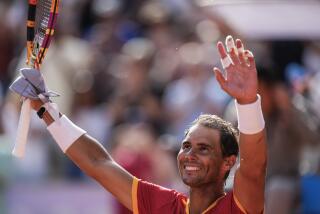Like McEnroe, Wilander Decides That It’s Time to Give Himself a Break
- Share via
Bjorn Borg was the first top tennis player stricken. Then Chris Evert Lloyd began to feel it. Last January, John McEnroe was hit. And now, it’s Mats Wilander. Tennis burnout has flared again.
Wilander, winner of four Grand Slam titles since 1982, is taking off for seven weeks and said he won’t come back until the Stockholm Open, which begins Nov. 3. Besides missing four Nabisco Grand Prix tournaments, he will skip Sweden’s semifinal Davis Cup match at Czechoslovakia.
“Mats has felt tired of tennis for a long time,” Hans Olsson, Sweden’s Davis Cup captain, said. “I think he has made a wise decision before it’s too late.”
Wilander is only 22. Yet, “I feel tired of tennis and everything about it,” he said when he announced his self-imposed hiatus. “It’s not fun to practice any more. You risk a burnout if you don’t take a break, and I hope to rest one or two months every year from now on.”
Wilander left as McEnroe returned from a seven-month break that began last January when he said he was mentally and physically exhausted.
Borg, another Swede, began the trend in 1982 when, after being replaced by McEnroe as the world’s No. 1-ranked player, he walked away from tennis. Earlier this year, Borg said he didn’t miss the sport he had dominated for so long.
“I’m proud of what I did. But I realize that was not what I wanted to do with my life,” he said.
No one talked about “burnout” then, and McEnroe criticized Borg’s decision at the time. His feelings since have changed.
“Tennis is the only sport where you don’t have time off to rejuvenate yourself mentally and physically,” McEnroe said during his sabbatical. “I have no intention of retiring, but I have every intention of cutting back on playing. Maybe I’ll play nine months a year from now on; maybe I’ll play eight months.”
A four-time U.S. Open champion and three-time winner at Wimbledon, McEnroe failed to win a Grand Slam title in 1985 and slipped from No. 1 to No. 2 in the world computer rankings.
He said the mounting pressure that goes with the year-round pro tennis circuit took its toll.
“I was warned for years . . . I was playing too much,” McEnroe said. “I’ve been saying since I was 18 years old that tennis should not be a 12-month sport, but no one paid attention. If they had paid attention, I think tennis would be in much better shape now.
“After eight years of the professional tour, I know what’s best for me,” McEnroe said. “What’s best for me is best for the sport.”
Tennis is the only sport that has no off-season. Unlike baseball, basketball, football, soccer and even golf, tennis is played year-round.
The week after the men stage their “year-ending” Nabisco Masters Dec. 1-7 at New York, a singles-only event, the “year-ending” WCT Doubles will be held in England and the Davis Cup final is scheduled Dec. 19-21.
Even during Christmas week, there’s a $105,000 event at Melbourne, the beginning of the Australian segment of the tour.
Under rules established by the Men’s International Professional Council, the men must play a minimum of 14 Nabisco Grand Prix tournaments a year. If a player decides to play in all four Grand Slam events--Wimbledon and the French, U.S. and Australian opens--plus the Lipton International Players Championships, it means playing a total of 19 weeks.
That doesn’t sound like much. But, if a player qualifies, he also must play the Nabisco Masters, the Buick WCT Finals, the Shearson Lehman Tournament of Champions and the WCT Doubles--the four MIPTC “circuit championships.”
Add another four weeks--that’s 23.
Then if a player wants to peak at the Australian Open in January, Lipton in February, the French Open in May, Wimbledon in June, the U.S. Open in September and the Nabisco Masters in December, he must play several tournaments in the preceding weeks to prepare. That could be another 12 weeks.
Then there could be four weeks for Davis Cup.
There also are the special events--exhibitions in which a player must perform because of a contract with a clothing or racket manufacturer.
The constant travel adds to the problem. Last year, Ivan Lendl of Czechoslovakia won three tournaments in three weeks on three different surfaces, and he had to cross the Atlantic twice during that span, winning at Fort Myers, Fla., on hardcourt, at Monte Carlo on clay and at Dallas on carpet.
Jimmy Connors, who plays the game with such zest and enjoyment at age 34, has created his own off-season, staying home with his family during the last two months of the year rather than traveling to Australia.
Several years ago, Lloyd solved the problem by taking off during the beginning of each year, skipping most of the indoor tournaments.
“The top players are pulled in so many directions,” said Lloyd, 31 and ranked No. 2 in the world. “It’s real tough. I’m not playing the WITA Championships, and I’m president of the WITA (Women’s International Tennis Assn.). You can’t please everyone.
“The tourneys or the draws have to be cut down or you’ll burn out the players. The life span will be five years. I didn’t join the tour until I was 18; they’re doing it at 14 or 15 now. If you do that, you’re not going to be playing at 30.”
More to Read
Go beyond the scoreboard
Get the latest on L.A.'s teams in the daily Sports Report newsletter.
You may occasionally receive promotional content from the Los Angeles Times.










